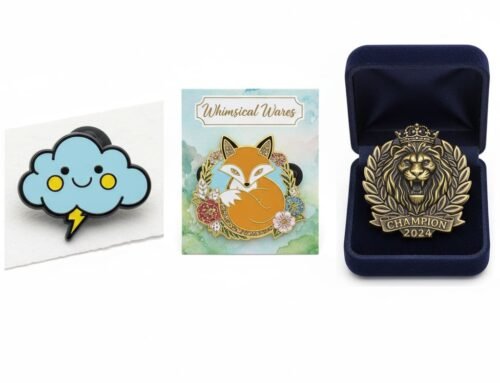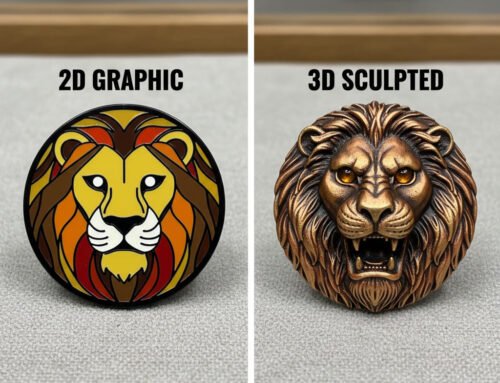You’ve perfected your pin’s design, but the part that nobody sees is what determines if your masterpiece stays securely on a jacket or gets lost on the pavement. The pin backing, or attachment, is the unsung hero of the custom pin world. It affects security, comfort, wearability, and even the perceived value of your pin. An incorrect choice can lead to a lost treasure or a damaged garment.
This is the most comprehensive guide to pin attachments you will find anywhere. We will explore every option, from the standard butterfly clutch to high-security locking mechanisms and innovative specialty fasteners. Drawing on our factory experience, we’ll provide the expert knowledge you need to choose the perfect backing for your specific project, ensuring your pins are not only beautiful but also perfectly functional. A great pin can be used in countless ways, as you’ll see in our guide to 15 Creative Ways to Use Custom Pins. This choice is a key part of the overall creation journey, which you can learn about in our Ultimate Guide to Custom Lapel Pins.
Tabla de contenido
- The Main Categories of Pin Backings
- A Deep Dive into the Most Common Pin Backings
- How to Keep Your Pins from Falling Off: A Guide to Locking Backs
- Innovative Solutions for Specific Needs
- From Lapel to Lifestyle: Adapting Your Design for Other Uses
- What B2B Buyers and Pro Designers Need to Know
- Your Pin Backing Problems, Solved
- Często zadawane pytania
- Let’s Find the Perfect Backing for Your Project
- Powiązane posty
The Main Categories of Pin Backings
To simplify your decision, we can group the dozens of available options into three main categories based on their primary function.
- Standard Attachments: The common, often free options perfect for everyday use and large giveaways. They provide a good balance of security and cost-effectiveness.
- High-Security Attachments: These are premium, upgraded options specifically designed to prevent pin loss, ideal for valuable collectibles or pins worn in active environments.
- Specialty Attachments: These are clever solutions designed to solve specific challenges, such as avoiding holes in fabric or attaching pins to formalwear.
A Deep Dive into the Most Common Pin Backings
These are the two options that 90% of customers will encounter first. They are the workhorses of the pin world, and understanding their subtle differences is your first step to making an informed choice. Best of all, they are standard free options, a key point we discuss in our Complete Breakdown of Custom Pin Pricing.
The Butterfly Clutch (or Military Clutch): The Industry Standard
The butterfly clutch is the most common pin backing in the world. It consists of a small metal base with two “wings” on either side. To use it, you simply squeeze the wings together to open the clasp and slide it off the pin post. It’s simple, effective, and has been the standard for decades.
- Pros: Very easy to use, lightweight, has a low and discreet profile, and is almost always included for free with your order.
- Cons: The grip can loosen over time with repeated use. It can also be accidentally released if the wings are squeezed by a heavy backpack strap or a fold in thick clothing.
- Lo mejor para: Promotional giveaways, event pins, and general daily wear where maximum security isn’t the absolute top priority.
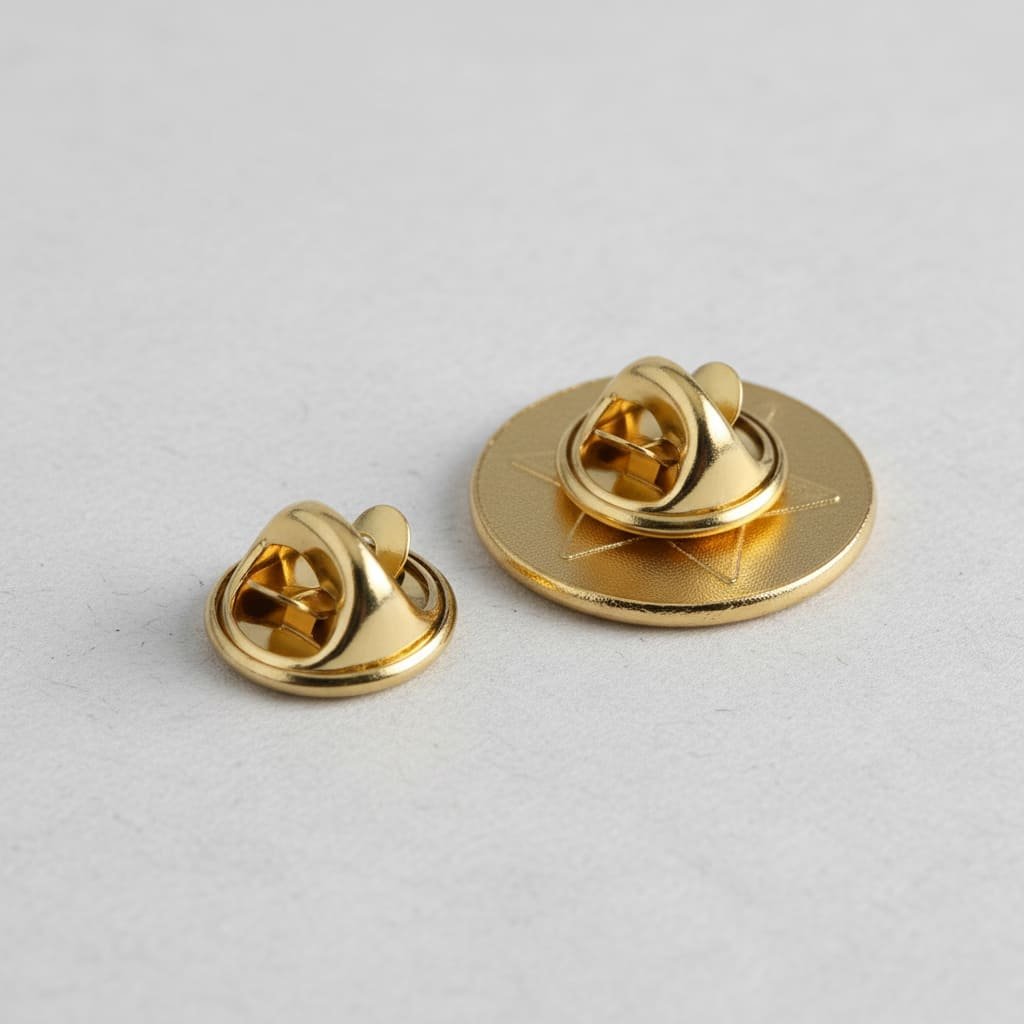
The Rubber Clutch (or PVC Clutch): The Modern Favorite
In recent years, the soft rubber clutch has exploded in popularity, especially among artists and fashion-forward brands. It’s a simple, pliable cap made of PVC or rubber that you push onto the pin post, where it grips securely with friction.
- Pros: More comfortable against the skin (no sharp metal edges), provides a surprisingly secure and snug fit, and comes in various colors (black, yellow, pink, etc.) that can be coordinated with your pin’s design. It is also a free, standard option.
- Cons: Over many years of exposure to direct heat and sunlight, the rubber can eventually degrade or harden. Some people with limited hand strength may find them harder to grip and pull off than a butterfly clutch.
- Lo mejor para: Pins worn on hats or t-shirts (close to the skin), artist pins where color coordination is a fun design element, and as a popular, comfortable alternative to the metal clutch.
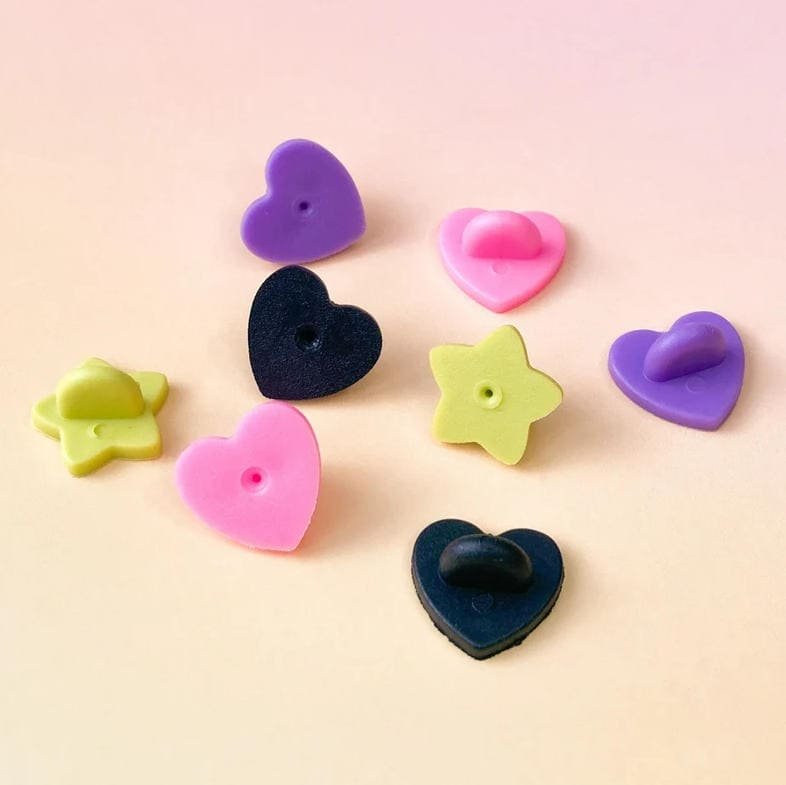
How to Keep Your Pins from Falling Off: A Guide to Locking Backs
This is one of our most frequently asked questions, and it addresses a major customer pain point. Losing a favorite or valuable pin is incredibly frustrating. High-security locking backs are premium, upgraded attachments specifically engineered to prevent this from happening, making them essential for pins you can’t afford to lose.
The Deluxe Clutch (Flathead & Ball-Top): Security Meets Style
The deluxe clutch is the most popular high-security option. It features a robust, spring-loaded mechanism inside a sturdy metal housing. To attach it, you simply push it onto the pin post until it clicks securely into place. It will not release until you purposefully pull up on the top portion of the clutch, disengaging the internal lock.
This style is essential for protecting higher-value pins, such as those with a premium Hard Enamel finish or those designed as part of a collectible limited edition series.
Pros: Extremely secure, very durable, and provides a high-end, professional look and feel. They give peace of mind that your pin is safe.
Cons: They are more expensive than standard clutches, typically adding around +$0.30 per pin to your order. They also require two hands to remove.
Lo mejor para: Corporate gifts like the ones in our employee morale case study, valuable collectibles, or any pin that will be worn on outerwear, bags, or backpacks that see a lot of movement.
How a Locking Pin Back Actually Works (The Mechanical Breakdown)
Ever wondered what’s happening inside that tiny metal clutch? The mechanism is brilliantly simple and effective. It consists of a tiny metal ball and a spring housed inside the clutch. When you push the clutch on, the pin post forces a small metal ball against a spring. The post slides past, and the spring then pushes the ball firmly into the small groove on the pin post. At this point, it’s locked. Any attempt to pull the pin out only increases the pressure on the ball, tightening its grip and locking it even more securely.
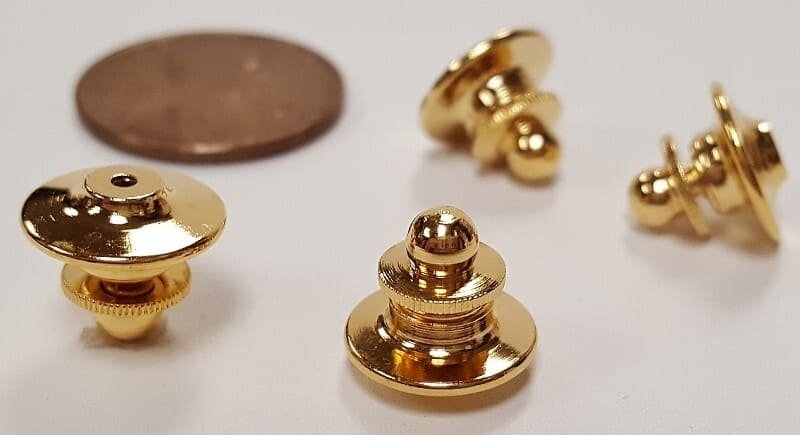
Pin Locks (with Set-Screw): The Ultimate Security
For situations that require the absolute maximum level of security, there is the pin lock. This is a type of locking back that slides onto the post and is then tightened into place with a small screw, which usually requires a tiny Allen key. Once tightened, it is virtually impossible for the pin to fall off accidentally. Because it requires a tool, it’s best for pins that will be semi-permanently displayed on a jacket or banner, or for highly valuable collectibles that need Fort Knox-level security.
Innovative Solutions for Specific Needs
Beyond standard fasteners, there is a whole category of specialty attachments designed to solve unique challenges, from protecting delicate fabrics to attaching pins to formalwear.
Magnetic Backs: The No-Holes Solution
What if you want to wear a pin on an expensive suit, a silk scarf, or a delicate blouse without leaving a permanent hole? A magnetic back is the perfect solution. A strong magnet is attached to the back of the pin, and a separate metal plate or a second magnet is placed on the inside of the garment. The magnetic attraction holds the pin securely in place.
- Pros: Leaves absolutely no holes in fabric, making it ideal for delicate or valuable clothing. It’s also incredibly easy to apply, remove, and reposition.
- Cons: It’s less secure than a physical post and can be dislodged by a seatbelt or a heavy bag strap. It’s not suitable for very thick fabrics (like a heavy wool coat) or for very active situations. It is also a premium option, adding +$0.75 to $1.00 to the per-pin cost.
- Important Safety Note: Magnetic backings should not be used by or near individuals with pacemakers.
This attachment is a fantastic choice for professional events, and you can learn more about its application in our checklist for trade show success.
Safety Pins: The Heavy-Duty Classic
A familiar and reliable option, the safety pin backing is a traditional mechanism integrated into the back of the pin. It’s incredibly secure and easy for anyone to understand and use. Its wider base is excellent at distributing the weight of larger or heavier pins, preventing them from drooping. This makes it a great choice for pins over 2 inches, pins with heavy special effects like glitter, or for attaching pins to thick, non-clothing materials like a canvas backpack or a corkboard.
From Lapel to Lifestyle: Adapting Your Design for Other Uses
A great pin design is versatile. With a few simple changes to the attachment, you can transform your design into a whole range of custom products. This is a fantastic way to expand your merchandise line while maintaining a consistent brand identity.
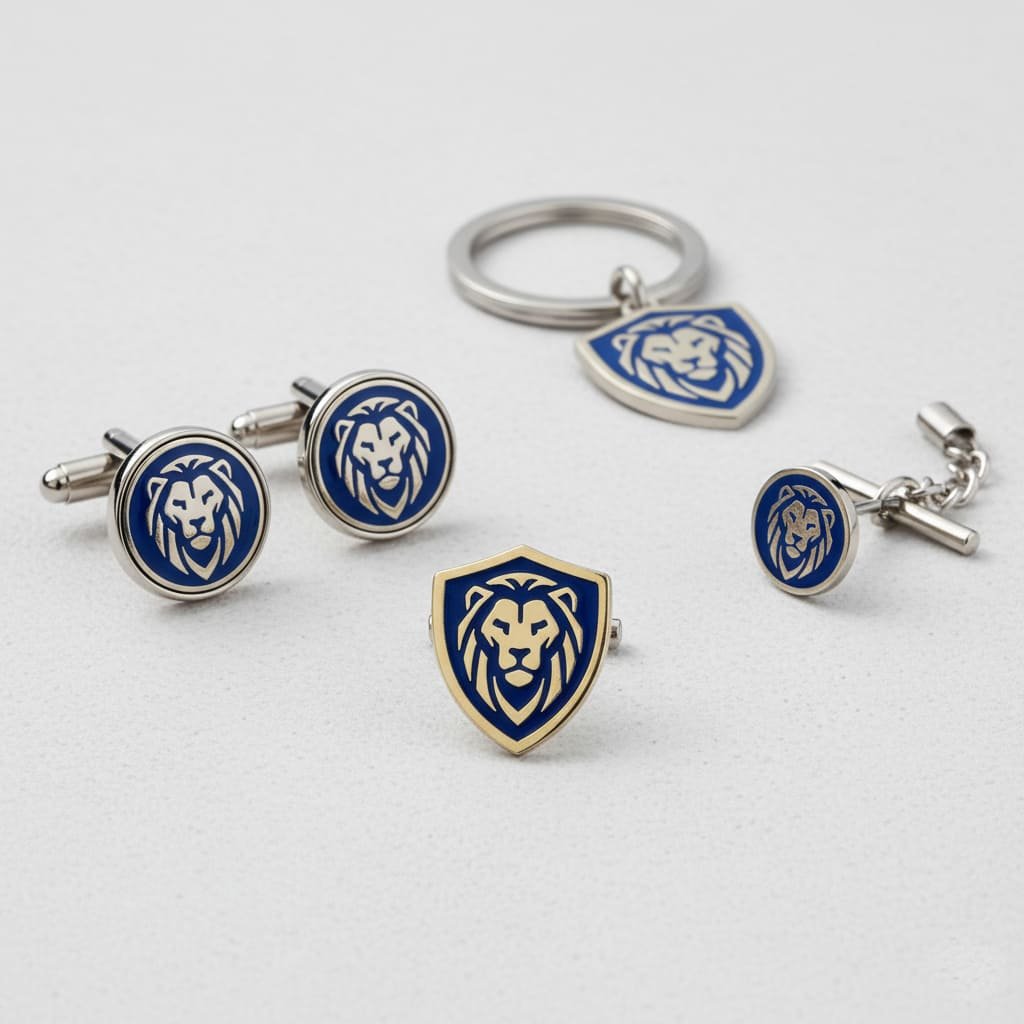
- Cufflink Attachments: The same pin “face” can be attached to a cufflink backing instead of a pin post, turning your design into a sophisticated formal accessory.
- Tie Tacks & Tie Clips: A tie tack with a chain is a classic accessory. The pin goes through the tie and is secured by a clutch, while a small chain connects to a T-bar that slips into a shirt buttonhole, keeping the tie perfectly in place.
- Key Chain Attachments: By adding a small loop to your pin’s mold during production, your design can be easily attached to a key ring, transforming it into a custom keychain.
What B2B Buyers and Pro Designers Need to Know
Beyond the basics, a few expert-level details can make the difference between an amateur product and a professional one.
The Rule of Two Posts: Preventing Spinning
This is a critical rule for professional results: any pin that is over 1.5 inches long, has a tall and narrow shape, or is heavier due to a 3D mold design, should have two pin posts on the back. A single post acts as a pivot point, allowing a larger pin to spin, droop, or hang crookedly. Two posts anchor the pin securely in place, ensuring it always displays exactly as intended. This is one of the most important lessons in our 10 Critical Design Tips guide.
Backing Options and Price Impact Table
Summary of Pin Backing Options
| Tipo de respaldo | Security Level | Comfort Level | Added Cost Per Pin (Approx.) | Mejor para |
|---|---|---|---|---|
| Embrague de mariposa | Standard | Medium | Free (Standard) | General Use, Giveaways |
| Embrague de goma | Good | High | Free (Standard) | Wearing Against Skin, Artist Pins |
| Deluxe Clutch | High | High | +$0.30 | Valuable Pins, Bags, Outerwear |
| Pin Locks (Tool) | Maximum | Medium | +$0.50+ | Permanent Display, Collections |
| Magnetic Back | Medium | High | +$0.75 | Delicate Fabrics, Formalwear |
| Pasador de seguridad | High | Low-Medium | +$0.15 | Heavy Pins, Thick Fabric |
Your Pin Backing Problems, Solved
Even with the best backings, issues can sometimes arise. Here’s how to troubleshoot the most common problem.
“Help! My Locking Pin Back is Stuck!”
First, don’t panic! This is a common issue and is almost always fixable. The internal mechanism can sometimes get snug.
- Reset the Mechanism: Gently press the entire backing *down* onto the post a little further. This can help reset the internal spring and ball. Then, try pulling up on the top portion to release it again.
- Try Twisting: Gently twist the backing around the post. Sometimes a tight fit from the metal plating can cause it to bind, and twisting can help loosen the grip.
- Check the Post: Make sure the pin post itself is not bent, as a bent post can jam the locking mechanism.
Preguntas frecuentes
- Butterfly clutch vs. rubber clutch: which one is *really* better?
- It’s truly a matter of preference. Both are excellent free options. Butterfly clutches are classic and reliable. Rubber clutches are more comfortable against the skin, offer a slightly snugger fit, and come in fun colors. We recommend rubber clutches for any pin that will be worn directly on a t-shirt or hat.
- What is the absolute most secure pin back?
- For removable security, the Deluxe Locking Clutch is the top choice for 99% of users. For semi-permanent security where you won’t be removing it often, a Pin Lock with a set-screw is the most secure option available.
- How do I keep my pin from spinning around?
- Use a pin with two posts. This is the only guaranteed way to prevent rotation and is a standard practice for any pin over 1.5 inches in length.
- Will a magnetic back hold through a thick leather jacket?
- Probably not effectively. Magnetic backings are strongest on thinner materials like dress shirts, blazers, and scarves. For thick, heavy materials like leather or denim, a traditional post and a secure locking clutch is a much more reliable choice.
Let’s Find the Perfect Backing for Your Project
Choosing the right finish is one of the most exciting parts of the design process. A great backing is the foundation of a great pin, and thoughtful packaging completes the presentation. Our experts are here to help you make the best choice for your project, from the pin itself to a professional look with our Buyer’s Guide to Custom Pin Packaging.

